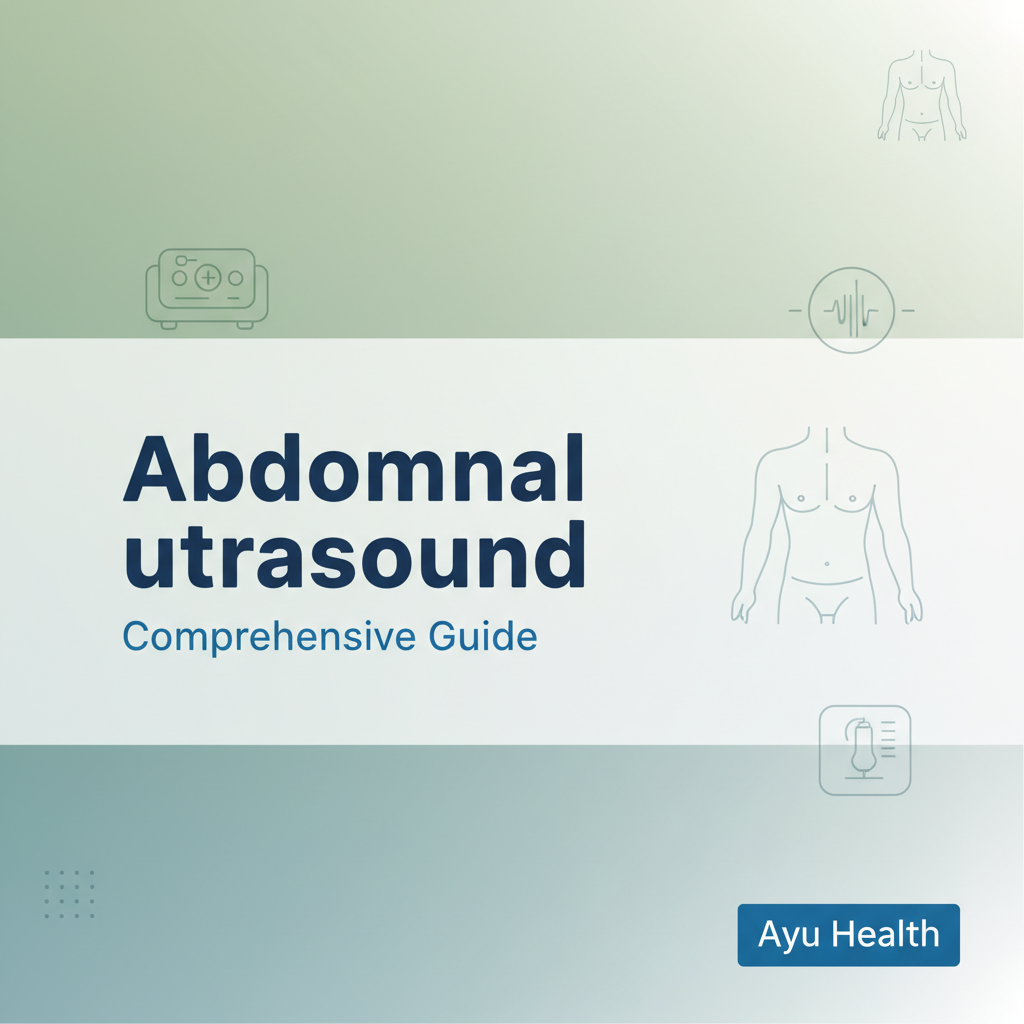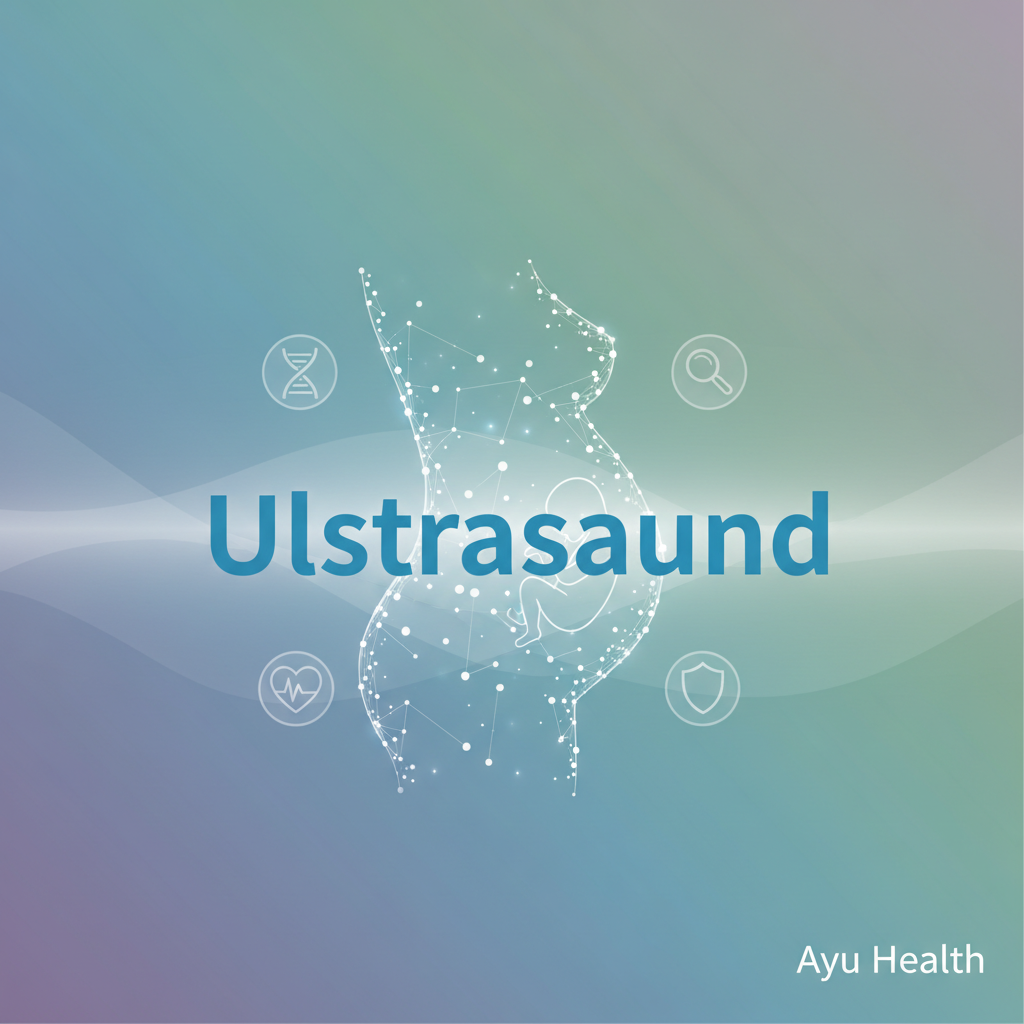What is Abdominal Ultrasound: Purpose, Procedure, Results, Preparation & Costs in India
Abdominal pain, persistent bloating, or unexplained weight loss can be incredibly unsettling. When these symptoms arise, understanding the cause becomes paramount. One of the most common and effective diagnostic tools for investigating abdominal issues is the abdominal ultrasound. This blog post aims to provide a comprehensive guide to abdominal ultrasound specifically tailored for patients in India. We'll cover everything from its purpose and procedure to preparation, results, risks, and costs, empowering you with the knowledge you need to navigate this important diagnostic test.
What is an Abdominal Ultrasound?
An abdominal ultrasound, also known as a USG abdomen or abdominal sonography, is a non-invasive imaging technique that uses high-frequency sound waves to create detailed images of the organs and structures within your abdomen. Think of it like sonar for your insides! A small, handheld device called a transducer emits these sound waves, which bounce off the internal organs. The returning echoes are then processed by a computer to create real-time images displayed on a screen.
Unlike X-rays or CT scans, abdominal ultrasounds don't use ionizing radiation, making them a safe and preferred option for many patients, including pregnant women and children when clinically appropriate. The procedure is generally painless and provides valuable information about the size, shape, structure, and condition of your abdominal organs.
Why is an Abdominal Ultrasound Performed? (Conditions & Indications)
An abdominal ultrasound is a versatile diagnostic tool used to investigate a wide range of conditions and symptoms affecting the abdomen. Doctors often recommend it to:
- Diagnose Gallstones: Ultrasound is highly effective in detecting gallstones within the gallbladder and bile ducts.
- Evaluate Liver Disease: It can help identify various liver conditions, including fatty liver disease (steatosis), cirrhosis, tumors, and infections. It also helps in assessing liver enlargement.
- Detect Kidney Stones: Ultrasound can often visualize kidney stones, although smaller stones may be harder to detect.
- Identify Abdominal Aortic Aneurysms (AAA) or Other Vascular Abnormalities: Ultrasound can help screen for and monitor AAAs, a potentially life-threatening condition where the aorta (the main artery carrying blood from the heart) bulges. It can also assess blood flow in other major abdominal vessels.
- Investigate Persistent Abdominal Pain: When you experience recurring or unexplained abdominal pain, an ultrasound can help pinpoint the source by revealing abnormalities in the organs.
- Evaluate Bloating: Ultrasound can help determine if bloating is caused by fluid accumulation (ascites), enlarged organs, or other abdominal abnormalities.
- Assess Unexplained Weight Loss: In cases of unintentional weight loss, an ultrasound can help rule out underlying conditions affecting the abdominal organs.
- Evaluate Abnormal Blood Test Results: If blood tests reveal elevated liver enzymes or abnormal kidney function, an ultrasound can help investigate the cause.
- Guide Procedures Like Biopsies or Fluid Drainage: Ultrasound imaging can be used to guide the placement of needles during biopsies (tissue sampling) or fluid drainage procedures (e.g., removing ascites fluid).
- Assess Blood Flow: Doppler ultrasound, a special type of ultrasound, can assess the blood flow through the abdominal vessels.
- Evaluate Intestinal Diseases: In some cases, ultrasound can help evaluate intestinal diseases like Crohn's disease or bowel obstructions.
In essence, if you're experiencing any persistent or concerning abdominal symptoms, your doctor may recommend an abdominal ultrasound to gain a clearer picture of what's happening inside your body.
Who Needs an Abdominal Ultrasound? (Patient Profiles)
While an abdominal ultrasound can be beneficial for a wide range of individuals, certain patient profiles are more likely to be recommended for this test. These include:
- Individuals with Persistent Abdominal Pain: Anyone experiencing ongoing or recurring abdominal pain that doesn't have a clear cause.
- Patients with Suspected Gallbladder Issues: Those with symptoms like upper right abdominal pain, nausea, vomiting, or jaundice (yellowing of the skin and eyes), which may indicate gallstones or gallbladder inflammation.
- Individuals with Liver Disease Risk Factors: People with a history of alcohol abuse, hepatitis, obesity, or diabetes, who are at higher risk of developing liver conditions like fatty liver disease or cirrhosis.
- Patients with Kidney Problems: Individuals with symptoms like flank pain (pain in the side), blood in the urine, or frequent urination, which may suggest kidney stones or other kidney abnormalities.
- Individuals with a Family History of Abdominal Aortic Aneurysm (AAA): Those with a family history of AAA may be screened with ultrasound to detect the condition early.
- Patients with Abnormal Liver or Kidney Function Tests: Individuals with elevated liver enzymes (AST, ALT) or abnormal creatinine levels in their blood tests may need an ultrasound to investigate the underlying cause.
- Individuals Experiencing Unexplained Weight Loss: People who are losing weight without trying, especially if accompanied by other abdominal symptoms.
- Patients Being Monitored for Existing Conditions: Individuals with previously diagnosed conditions like liver cirrhosis or kidney cysts may undergo regular ultrasounds to monitor their progression.
It's important to remember that your doctor will assess your individual symptoms, medical history, and risk factors to determine if an abdominal ultrasound is the appropriate diagnostic test for you. Don't hesitate to discuss your concerns and ask questions.
Preparation for an Abdominal Ultrasound (India-Specific Tips)
Proper preparation is crucial for obtaining clear and accurate ultrasound images. Here's what you need to know, with some tips tailored for Indian patients:
- Fasting: In most cases, you'll be asked to fast for 8-12 hours before the ultrasound. This means no food or drinks (except water) during this period. Fasting helps reduce gas in the abdomen, which can interfere with the ultrasound images. Tip for India: Inform the diagnostic center about any medical conditions you have, such as diabetes, that might require adjustments to the fasting guidelines.
- Avoid Chewing Gum or Smoking: Avoid chewing gum or smoking before the procedure, as these can introduce air into your digestive system and affect the clarity of the images.
- Clothing: Wear comfortable, loose-fitting clothing to your appointment. You may be asked to change into a gown. Tip for India: Choose clothing that is easy to remove and put back on, considering the weather and potential lack of private changing spaces in some centers.
- Jewelry: Remove any jewelry or metallic objects from your abdominal area, as these can interfere with the ultrasound waves.
- Full Bladder (for Pelvic Ultrasound): If your doctor has requested a pelvic ultrasound in addition to the abdominal ultrasound (to visualize the bladder, uterus, or ovaries), you may need to drink several glasses of water (around 1 liter) about an hour before the procedure to ensure a full bladder. A full bladder helps provide a clearer view of these organs. Tip for India: Plan your travel to the diagnostic center accordingly to avoid needing to urinate before the ultrasound.
- Medications: Inform your doctor about all the medications you are taking, including over-the-counter drugs and herbal supplements. In most cases, you can continue taking your regular medications, but your doctor may advise you otherwise.
- Previous Reports: Bring any relevant medical records, including previous ultrasound reports, CT scans, or X-rays, to your appointment. This will help the radiologist interpret the results more accurately.
- PCPNDT Act Compliance: Be prepared to provide valid identification (like Aadhaar card, PAN card, or passport) and a referral form from a registered medical practitioner, as required under the Pre-Conception and Pre-Natal Diagnostic Techniques (PCPNDT) Act, 1994. This act aims to prevent sex determination and ensure ethical practices in ultrasound centers.
By following these preparation guidelines, you can help ensure that your abdominal ultrasound is performed smoothly and yields accurate results.
Abdominal Ultrasound Procedure: A Step-by-Step Guide
Knowing what to expect during the procedure can help ease any anxiety you may have. Here's a step-by-step guide to the abdominal ultrasound process:
- Arrival and Registration: Upon arrival at the diagnostic center, you will typically be asked to fill out some paperwork and provide your identification and referral form.
- Changing into a Gown (if required): Depending on the center's policy and the type of clothing you're wearing, you may be asked to change into a hospital gown.
- Meeting the Sonographer: A trained sonographer will perform the ultrasound. They will explain the procedure to you and answer any questions you may have.
- Positioning on the Examination Table: You will be asked to lie down on an examination table, usually on your back. The sonographer may ask you to adjust your position slightly during the scan to get better images.
- Applying the Gel: The sonographer will apply a clear, water-based gel to your abdomen. This gel helps the transducer make good contact with your skin and allows the sound waves to travel more effectively. The gel may feel cool to the touch.
- Scanning with the Transducer: The sonographer will then press the transducer (the handheld device) against your abdomen and move it around to capture images of the underlying organs. You may feel slight pressure as the transducer is moved.
- Breathing Instructions: During the scan, the sonographer may ask you to hold your breath temporarily or take deep breaths. This helps to improve the clarity of the images by minimizing movement.
- Image Acquisition: The transducer emits high-frequency sound waves that bounce off the internal organs. These echoes are received by the transducer and converted into real-time images displayed on a monitor. The sonographer will carefully examine these images to assess the size, shape, and structure of your abdominal organs.
- Duration of the Scan: The entire procedure usually takes between 15 and 30 minutes, but it may take longer depending on the complexity of the case and the number of organs being examined.
- Cleaning the Gel: Once the scan is complete, the sonographer will wipe off the gel from your abdomen.
- Report Generation: The sonographer will then send the images to a radiologist, a doctor who specializes in interpreting medical images. The radiologist will analyze the images and write a report summarizing the findings.
- Receiving the Results: You will usually receive the report on the same day or the next day, depending on the center's policy. Your healthcare provider will then review the report with you and discuss the findings and any necessary follow-up steps.
The abdominal ultrasound is a painless and relatively quick procedure. The sonographer will do their best to make you comfortable throughout the process.
Understanding Your Abdominal Ultrasound Results
After the ultrasound is complete, the radiologist will analyze the images and prepare a detailed report. This report will be sent to your referring doctor, who will then discuss the findings with you. Understanding the key elements of the report is crucial for informed decision-making about your health.
Here's what you can expect to find in your abdominal ultrasound report:
- Description of the Organs: The report will describe the size, shape, and appearance of each organ examined, including the liver, gallbladder, kidneys, pancreas, spleen, and major blood vessels.
- Presence of Any Abnormalities: The report will note any abnormalities detected, such as gallstones, kidney stones, cysts, tumors, enlarged organs, or fluid accumulation.
- Measurements: The report may include measurements of certain organs or structures, such as the diameter of the aorta or the size of a liver lesion.
- Doppler Findings (if applicable): If Doppler ultrasound was used to assess blood flow, the report will describe the blood flow patterns in the major vessels.
- Impression/Conclusion: This is a summary of the key findings and the radiologist's interpretation of the results. It may include a diagnosis or a list of possible diagnoses.
- Recommendations: The report may recommend further testing, such as a CT scan or MRI, or suggest follow-up appointments with your doctor.
Important Considerations for Indian Patients:
- Consult with Your Doctor: The ultrasound report is just one piece of the puzzle. It's essential to discuss the results with your doctor, who can interpret them in the context of your overall medical history, symptoms, and other test results.
- Don't Self-Diagnose: Avoid trying to interpret the ultrasound report yourself. The medical terminology can be confusing, and it's easy to misinterpret the findings.
- Ask Questions: Don't hesitate to ask your doctor questions about the report. Make sure you understand the findings and what they mean for your health.
- Seek a Second Opinion (if needed): If you have any doubts or concerns about the results, you can always seek a second opinion from another radiologist or specialist.
- Follow-Up as Recommended: It's important to follow your doctor's recommendations for further testing or treatment.
Your doctor will use the information from the ultrasound report to develop a personalized management plan that addresses your specific needs.
Risks and Side Effects of Abdominal Ultrasound
One of the primary advantages of abdominal ultrasound is its safety. It's a non-invasive procedure that doesn't involve any ionizing radiation, unlike X-rays or CT scans. As a result, the risks and side effects associated with abdominal ultrasound are minimal.
- No Radiation Exposure: This is a major advantage, especially for pregnant women and children, as it eliminates the risk of radiation-related health problems.
- Painless Procedure: The procedure is generally painless. You may feel some slight pressure from the transducer as it's moved across your abdomen, but it shouldn't be painful.
- Rare Allergic Reaction to Gel: In very rare cases, some individuals may experience a mild allergic reaction to the ultrasound gel, causing skin irritation or redness. This is usually temporary and resolves on its own.
- No Long-Term Side Effects: There are no known long-term side effects associated with abdominal ultrasound.
While abdominal ultrasound is generally safe, there are some limitations to consider:
- Image Quality Can Be Affected by Gas: The presence of gas in the abdomen can interfere with the ultrasound waves and make it difficult to obtain clear images. This is why fasting is often required before the procedure.
- Obesity Can Affect Image Quality: In obese individuals, the ultrasound waves may have difficulty penetrating the deeper tissues, which can also affect image quality.
- Limited Visualization of Certain Structures: Ultrasound may not be able to visualize certain structures as clearly as other imaging techniques, such as CT scans or MRI.
Overall, abdominal ultrasound is a safe and well-tolerated procedure with minimal risks. If you have any concerns, discuss them with your doctor before the procedure.
Abdominal Ultrasound Costs in India (₹ Ranges)
The cost of an abdominal ultrasound in India can vary depending on several factors, including the location of the diagnostic center, the reputation and accreditation of the center, the type of ultrasound, and any additional services offered.
Here's a general overview of the cost ranges you can expect:
- Basic Abdominal Ultrasound: The price for a basic abdominal ultrasound typically starts around ₹800 to ₹1500 in smaller towns and cities.
- Advanced Abdominal Ultrasound (with Doppler): If Doppler ultrasound is used to assess blood flow, the cost may range from ₹1500 to ₹3000 or higher.
- High-End Diagnostic Centers in Major Cities: In larger metropolitan areas like Delhi, Mumbai, or Bangalore, the cost of an abdominal ultrasound at a well-established and accredited diagnostic center can range from ₹2000 to ₹4000 or more.
Factors Influencing the Cost:
- Location: Diagnostic centers in prime locations or major cities tend to charge more than those in smaller towns or rural areas. For example, an abdominal ultrasound price in Delhi could range from INR 800 to INR 1600.
- Reputation and Accreditation: Centers with a strong reputation and accreditation from organizations like the National Accreditation Board for Testing and Calibration Laboratories (NABL) may charge higher fees due to their commitment to quality and accuracy.
- Type of Ultrasound: Doppler ultrasound, which provides information about blood flow, is typically more expensive than a basic abdominal ultrasound.
- Additional Services: Some centers may offer additional services, such as doctor consultations or same-day reports, which can increase the overall cost.
- Discounts and Offers: Keep an eye out for discounts and special offers, which can help you save money on your ultrasound.
Tips for Finding Affordable Abdominal Ultrasound in India:
- Compare Prices: Call several diagnostic centers in your area and compare their prices.
- Ask About Discounts: Inquire about any discounts or special offers that may be available.
- Check for Accreditation: Choose a center that is accredited by NABL or another reputable organization.
- Consider Government Hospitals: Government hospitals and clinics often offer ultrasound services at subsidized rates.
- Negotiate: Don't be afraid to negotiate the price, especially if you're paying out-of-pocket.
It's important to remember that the cost of an abdominal ultrasound is an investment in your health. Choosing a reputable and accredited center is crucial for ensuring accurate results and proper diagnosis.
How Ayu Helps You Manage Your Abdominal Ultrasound Results
Ayu is a powerful tool designed to help you manage your medical records, including your abdominal ultrasound reports, efficiently and securely. Here's how Ayu can simplify your healthcare journey:
- Store Your Reports Securely: Ayu allows you to store all your medical reports, including ultrasound reports, in one secure digital location. No more worrying about lost or damaged paper copies.
- Track Your Health Over Time: Ayu enables you to track your ultrasound results over time, allowing you to monitor any changes or trends in your health. This is particularly useful for individuals with chronic conditions who require regular monitoring.
- Share Your Reports Easily: With Ayu, you can easily share your ultrasound reports with your doctor or other healthcare providers via a secure QR code or direct sharing link. This eliminates the need to carry physical copies of your reports to appointments.
- Organize Your Medical History: Ayu helps you organize your entire medical history, including lab results, prescriptions, and doctor's notes, making it easier to access and manage your health information.
- Set Reminders for Follow-Up Appointments: Ayu allows you to set reminders for follow-up appointments and medication refills, helping you stay on top of your healthcare schedule.
- Access Your Records Anytime, Anywhere: With Ayu, you can access your medical records from anywhere in the world, as long as you have an internet connection.
Ayu empowers you to take control of your health by providing you with a convenient and secure platform for managing your medical records.
Frequently Asked Questions (FAQ) About Abdominal Ultrasound
Here are some frequently asked questions about abdominal ultrasound to further clarify the process:
1. Is an abdominal ultrasound painful?
No, an abdominal ultrasound is generally painless. You may feel some slight pressure from the transducer as it's moved across your abdomen, but it shouldn't be painful.
2. How long does an abdominal ultrasound take?
The procedure usually takes between 15 and 30 minutes, but it may take longer depending on the complexity of the case.
3. Do I need to fast before an abdominal ultrasound?
In most cases, you'll need to fast for 8-12 hours before the test. This helps reduce gas in the abdomen, which can interfere with the images.
4. Can I drink water before an abdominal ultrasound?
Yes, you can usually drink water before the test, but avoid other beverages like tea, coffee, or juice.
5. What should I wear for an abdominal ultrasound?
Wear comfortable, loose-fitting clothing to your appointment. You may be asked to change into a gown.
6. Can an abdominal ultrasound detect cancer?
Ultrasound can detect some types of tumors in the abdomen, but it's not always the best imaging technique for detecting cancer. Other tests, like CT scans or MRI, may be needed for a more definitive diagnosis.
7. Is abdominal ultrasound safe for pregnant women?
Yes, abdominal ultrasound is generally considered safe for pregnant women because it doesn't use ionizing radiation.
8. How accurate is an abdominal ultrasound?
The accuracy of an abdominal ultrasound depends on several factors, including the quality of the equipment, the skill of the sonographer, and the presence of gas or obesity.
9. What if the ultrasound finds something abnormal?
If the ultrasound finds something abnormal, your doctor will discuss the findings with you and may recommend further testing or treatment.
10. Can I get a copy of my ultrasound report?
Yes, you are entitled to get a copy of your ultrasound report. You can also store it securely on the Ayu app for easy access and sharing.
We hope this comprehensive guide has provided you with a clear understanding of abdominal ultrasound. Remember to consult with your doctor for personalized advice and guidance regarding your health.



